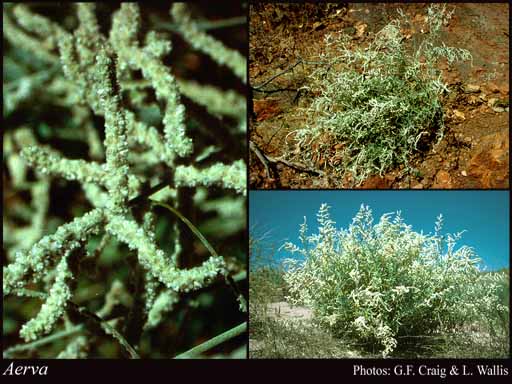- Reference
- Fl.Aegypt.-Arab. CXXII, 170 (1775)
- Name Status
- Current







Scientific Description
Family Amaranthaceae.
Habit and leaf form. Erect or decumbent herbs. Herbs perennial; plants with neither basal nor terminal concentrations of leaves. Leaves alternate, or opposite, or whorled; petiolate, or subsessile; simple. Leaf blades entire; elliptic, or obovate; pinnately veined; cuneate at the base. Leaves without stipules. Leaf blade margins entire.
Reproductive type, pollination. Fertile flowers hermaphrodite, or functionally male, or functionally female. Unisexual flowers present, or absent. Plants hermaphrodite, or dioecious. Female flowers with staminodes. Male flowers with pistillodes (rudimentary ovary and style).
Inflorescence and flower features. Flowers aggregated in ‘inflorescences’; in spikes. The terminal inflorescence unit cymose. Inflorescences terminal, or axillary; sometimes forming terminal panicles. Flowers sessile; bracteate; bracteolate. Bracteoles membranous. Flowers regular, or somewhat irregular; cyclic. Free hypanthium absent. Hypogynous disk absent. Perianth sepaline; 5. Calyx present; 5; polysepalous; hairy (usually, densely woolly in A. javanica); regular, or unequal but not bilabiate (the 2 outer sepals often slightly larger than the inner 3); green, or white; membranous but with a thicker green midrib; persistent; with the median member posterior. Sepals obovate. Corolla absent. Fertile stamens present, or absent. Androecium 5. Androecial members all equal, or markedly unequal (by misinterpretation); coherent; 1 - adelphous (the filaments basally connate forming a staminal cup); 1 -whorled. Androecium exclusively of fertile stamens (the true androecium alternating with subulate or rarely narrowly oblong and truncate or emarginate ‘pseudostaminodes’). Stamens 5; oppositisepalous. Anthers dehiscing via longitudinal slits; introrse; bilocular. Pollen shed as single grains. Gynoecium 2–3 carpelled. The pistil 1 celled. Gynoecium syncarpous; synstylovarious; superior. Ovary unilocular; 1 locular; sessile. Gynoecium stylate. Styles 1. Stigmas 2. Placentation basal. Ovules in the single cavity 1; pendulous; non-arillate; campylotropous.
Fruit and seed features. Fruit non-fleshy; indehiscent; capsular-indehiscent (a utricle, membranous, more or less compressed, breaking irregularly and falling with the sepals). Capsules splitting irregularly. Fruit 1 seeded. Seeds reniform in outline to lenticular; non-endospermic (strictly speaking). Perisperm present (abundant, mealy). Embryo well differentiated. Cotyledons 2. Embryo curved. Testa smooth (usually shiny).
Special features. Perianth (calyx) woolly outside.
Additional characters Stigmas the stigmatic area linear.
Taxonomic Literature
- Wheeler, J. R.; Rye, B. L.; Koch, B. L.; Wilson, A. J. G.; Western Australian Herbarium 1992. Flora of the Kimberley region. Western Australian Herbarium.. Como, W.A..